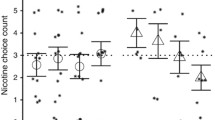Abstract
Multiple measures of cigarette smoking, subjective effect and physiological effect were collected during 90-min test sessions in normal volunteers. Before sessions subjects received oral doses of mecamylamine (2.5, 5.0, 10, 20 mg) or placebo. Each dose and placebo was given three times in a randomized block sequence. Mecamylamine increased several measures of cigarette smoking, including number of cigarettes, number of puffs per cigarette, and expired air carbon monoxide level. Mecamylamine also produced modest, dose-related decreases in standing blood pressure and increases in standing heart rate. The subjective effects produced by mecamylamine were not characteristic of those of psychoactive drugs. Mecamylamine appears to have increased cigarette smoking by decreasing the effective dose level of nicotine available from cigarette smoking.
Similar content being viewed by others
References
Chait LD, Griffiths RR (1982) Differential control of puff duration and interpuff interval in cigarette smokers. Pharmacol Biochem Behav 17:155–158
Chait LD, Griffiths RR (1983) Effects of caffeine on cigarette smoking and subjective response. Clin Pharmacol Ther 34:612–622
Chait LD, Griffiths RR (1984) Effects of methadone administration on human cigarette smoking and subjective response. J Pharmacol Exp Ther 229:636–640
Goldberg SR, Spealman RD, Risner MD, Henningfield JE (1983) control of behavior by intravenous nicotine injection in laboratory animals. Pharmacol Biochem Behav 19:1011–1020
Goldberg SR, Woods JH, Schuster CR (1969) Morphine: Conditioned increases in self-administration in rhesus monkeys. Science 166:1307–1307
Griffiths RR, Bigelow G, Henningfield JE (1980) Similarities in animal and human drug taking behavior. In: Mello NK (ed) Advances in substance abuse: Behavioral and biological research. Greenwich, CT: JAI Press, pp 1–90
Griffiths RR, Henningfield JE (1982a) Experimental analysis of human cigarette smoking behavior. Fed Proc 41:234–240
Griffiths RR, Henningfield JE (1982b) Pharmacological aspects of cigarette smoking. TIPS 3:260–263
Griffiths RR, Wurster J, Brady JV (1981) Choice between food and heroin: Effects of morphine, naloxone and secobarbital. J Exp Anal Behav 35:335–351
Gritz ER (1980) Smoking behavior and tobacco abuse. In: Mello NK (ed) Advances in substance abuse: Behavioral and biological research. Greenwich, CT: JAI Press, pp 91–158
Haertzen CA, Hickey JE (1985) Measurement of euphoria and other drug effects. In: Bozarth MA (ed) Methods of assessing the reinforcing properties of abused drugs. Brunswick, Maine: Haer Institute (in press)
Henningfield JE (1984) Behavioral pharmacology of cigarette smoking. In: Thompson T, Dews PB (eds) Advances in behavioral pharmacology Vol IV, New York: Academic Press
Henningfield JE, Chait LD, Griffiths RR (1983a) Cigarette smoking and subjective responses in alcoholics: Effects of pentobarbital. Clin Pharmacol Ther 33:806–812
Henningfield JE, Chait LD, Griffiths RR (1984) Effects of ethanol on cigarette smoking by volunteers without histories of alcoholism. Psychopharmacology 82:1–5
Henningfield JE, Goldberg SR (1983) Nicotine as a reinforcer in human subjects and laboratory animals. Pharmacol Biochem Behav 19:989–992
Henningfield JE, Griffiths RR (1979) A preparation for the experimental analysis of human cigarette smoking behavior. Behav Res Methods Instrum 11:538–544
Henningfield JE, Miyasato K, Jasinski DR (1983b) Cigarette smokers self-administer intravenous nicotine. Pharmacol Biochem Behav 19:887–890
Henningfield JE, Miyasato K, Johnson RE, Jasinski DR (1983c) Rapid physiological effects of nicotine in humans and selective blockade of behavioral effects by mecamylamine. National Institute on Drug Abuse Research Monograph, Volume 43, Problems of Drug Dependence, 1982 Government Printing Office, pp 259–265
Jarvik ME, Glick SD, Nakamura RK (1970) Inhibition of cigarette smoking by orally administered nicotine. Clin Pharmacol Ther 11:574–576
Jarvis MJ, Russell MAH, Saloojee Y (1980) Expired air carbon monoxide: A sample breath test of tobacco smoke intact. Br Med J 281:484–485
Jarvis M (1983) Treatment of cigarette dependence. Br J Addict 78:125–130
Keppel G (1973) Design and analysis: A researcher handbook. Englewood Cliffs. NJ: Prentice Hall
Kozlowski LT, Jarvik ME, Gritz ER (1975) Nicotine regulation and cigarette smoking. Clin Pharmacol Ther 17:93–97
Lucchesi BR, Schuster CR, Emley AB (1967) Role of nicotine as a determination of cigarette smoking frequency in man with observation of certain cardiovascular effects associated with the tobacco alkaloid. Clin Pharmacol Ther 22:789–796
McMorrow MJ, Foxx RM (1983) Nicotine's role in smoking: An analysis of nicotine regulation. Psychol Bull 93:302–327
Moss RA, Prue DM (1982) Research on nicotine regulation. Behav Ther 13:31–46
Nemeth-Coslett R, Griffiths RR (1984a) Determinants of puff duration in cigarette smokers: I. Pharmacol Biochem Behav 20:965–971
Nemeth-Coslett R, Griffiths RR (1984b) Determinants of puff duration in cigarette smokers: II. Pharmacol Biochem Behav 21:903–912
Rose JE, Jarvik ME, Anada S (1984) Nicotine preference increases after cigarette deprivation. Pharmacol Biochem Behavior 20:55–58
Stepney R (1980) Consumption of cigarettes of reduced tar and nicotine delivery. Br J Addict 75:81–88
Stolerman IP, Goldfarb T, Fink R, Jarvik ME (1973) Influencing cigarette smoking with nicotine antagonists. Psychopharmacologia 28:217–259
Tennant FS, Tarver AL, Rawson RA (1984) Clinical evaluation of mecamylamine for withdrawal from nicotine dependence. In: Harris LS (ed) Problems of drug dependence, National Institute on Drug Abuse, Research Monograph, Volume 49, (ADM) 84–1316, Washington, D.C., Government Printing Office
Woods JH, Downs DA, Carney J (1975) Behavioral functions of narcotic antagonists: Response-drug contingencies. Fed Proc 34:1777–1784
Author information
Authors and Affiliations
Rights and permissions
About this article
Cite this article
Nemeth-Coslett, R., Henningfield, J.E., O'Keeffe, M.K. et al. Effects of mecamylamine on human cigarette smoking and subjective ratings. Psychopharmacology 88, 420–425 (1986). https://doi.org/10.1007/BF00178502
Received:
Revised:
Issue Date:
DOI: https://doi.org/10.1007/BF00178502




